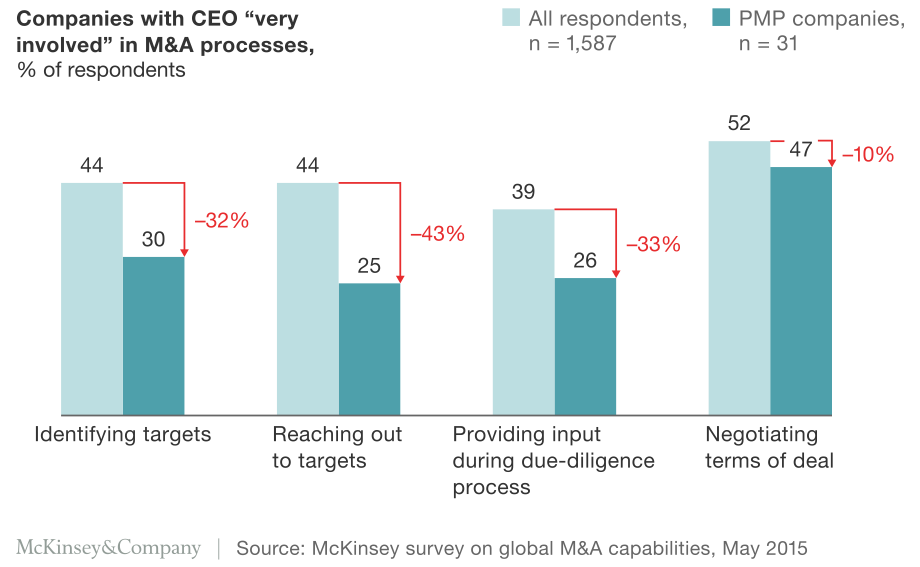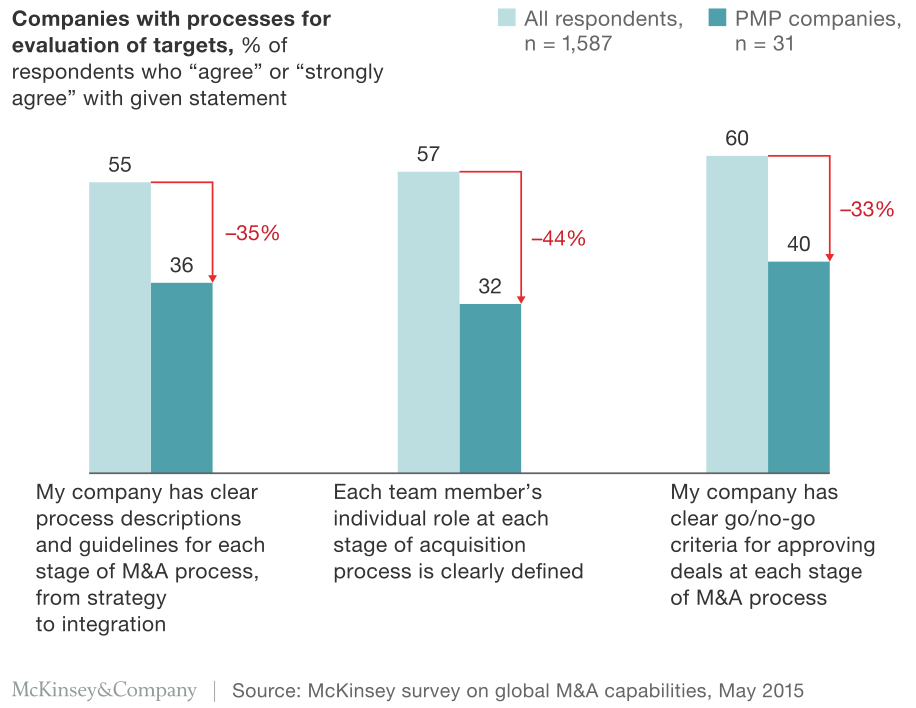
Publications Pharma M&A: Agile Shouldn’t Mean Ad Hoc
- Publications
Pharma M&A: Agile Shouldn’t Mean Ad Hoc

SHARE:
By Ankur Agrawal, Ruth De Backer, Spring Liu – McKinsey & Company
Contributors: Alvaro Aguero, Matthew Van Wingerden
Under pressure to be active acquirers, some pharmaceutical and medical-products companies may be neglecting best practices. Here’s where they can most improve.
The spate of recent megamergers among both pharmaceutical and medical-products (PMP) companies has made for eye-opening headlines, not just for the supersizing of these industry-consolidating deals, but also because it seemed to mark a break from the industry’s usual pattern of M&A. In the background, though, most PMP companies continued their usual focus on the rapid completion of many smaller deals to acquire innovation and fill selected portfolio and capability gaps.
That’s been a good approach for them. Analysis of global 1,000 companies over the past decade shows that PMP companies with high-volume M&A programs reliably outperform peers with respect to excess total return to shareholders—which is consistent with the results from other industries. So it’s no surprise that many executives in the industry expect an uptick in smaller deals, according to McKinsey’s latest survey on M&A. Nearly three-quarters of respondents from PMP companies report that they expect the number of deals to increase in 2016 and the size of deals to be the same as or smaller than in 2015. That’s also consistent with what we’ve historically seen outside of megamerger booms.
For some, it also marks a moment to revisit best practices. As essential as agility is for the fast-paced acquisition of programmatic M&A, it’s not an excuse for the kind of ad hoc approach we’ve encountered in far too many deal teams. And even otherwise-strong performers will benefit. When we examined the survey for insights from PMP respondents, we found three areas in particular where companies could be doing better: keeping the right level of CEO involvement, standardizing the process wherever practical, and reinforcing feedback mechanisms.
Keep the CEO involved
Because of the high volume and relatively low value of deals, PMP companies often entrust M&A work to lower levels of the organization than companies do in other industries, especially in the earlier phases of the deal funnel. In many companies, we encounter periodic business-development processes where the CEO and CFO don’t review and approve or kill deal proposals until the end. As such, they forgo involvement in shaping target identification and diligence during the formative stages of a deal. For identifying targets, reaching out to targets, and conducting due diligence on targets, PMP companies are roughly one-third less likely to report their CEO as being “very involved” in the process (Exhibit 1). The role of senior leadership is much more focused on setting the high-level, strategic direction of the business-development team and checking in on the last stages of asset deals. Such delegation is consistent with the targeted nature of these acquisitions, in which the deal model may be concerned with as little as a single molecule or medical device that requires deep expertise on the part of the acquisition team, as opposed to the need for a broad consensus.
It’s true that the fast pace and high variability of subject-matter-specific inputs for due diligence demand flexibility. And the reality on the ground often doesn’t neatly fit a rigid set of processes in which the same functions are brought into the deal analysis the same way each time. But when the amount of senior-management involvement in the M&A recipe is reduced, the result is often looser definition of the deal-making processes, roles, and criteria than in other sectors (Exhibit 2).
Exhibit 1. Pharmaceutical and medical-products companies pursue M&A with less senior involvement.

Exhibit 2. Pharmaceutical and medical-products companies rely less on standardized processes and guidelines.

Standardize the process wherever practical
Consistency and standardization may look different for PMP companies, but these qualities can still be practical—and worthwhile. Our analysis finds that companies taking a systematic approach perform better over time, which is consistent with the cross-industry trends.
Deal managers can establish a playbook of repeatable end-to-end processes for specific deal types, such as acquisitions of companies with products on the market, takeovers of companies with preapproved products, or licensing deals for products or intellectual property. A playbook would include, for example, stage gates, role descriptions, descriptions of deal owners and cross-functional deal teams, and common tools. And even with some standardization, managers still have the option of pulling in appropriate subject-matter experts from across the organization.
The lack of standardization is apparent in how M&A practitioners in PMP companies perceive their performance in discrete M&A-related activities. When looking across the target-sourcing process, the survey finds that PMP companies see themselves as outperforming the cross-sector average in activities that are more execution oriented, but not in activities more closely oriented to defined processes or playbooks. While this could be the result of either less attempt to standardize processes or less success when attempting to do so, the relative lack of standardization is clear.
Reinforce feedback mechanisms
The asset-based nature of many healthcare-manufacturer deals may limit the opportunity to perform the traditional postintegration analysis, with many companies merely aggregating it into the budget process without breaking out results for particular deals. Yet some forms of retrospective analysis and performance feedback are critical to consolidate deal lessons and build institutional capabilities over time. These feedback loops add the kind of transparency and accountability that establish M&A as a competitive advantage.
Based on the survey data, this may be an area that offers PMP companies significant opportunities for improvement. Survey respondents, all of whom claim to be knowledgeable about their companies’ M&A activity, are more than twice as likely to report not knowing how deals in the past five years have performed relative to plans as they are to report knowing.
Senior managers at leading PMP companies typically review performance with deal teams to reassess their target evaluation, deal execution, and integration processes for lessons learned. Managers at one medical-device manufacturer, for example, typically organize structured postdeal review sessions to discuss successes and areas for improvement, with an eye on improving future deals and building their team’s capability. Each session usually includes a thorough analysis of how different elements of the deal process contribute to the company’s ability to capture revenue and cost synergies, for example, and can highlight strengths and weaknesses in the team’s ability to track and measure discrepancies in the investment thesis to improve future performance.
The PMP industries seem destined to renew their focus on frequent, smaller acquisitions as a main source of innovation. Whether or not the wave of megamergers is over, a high volume of small deals will require M&A teams to act quickly with the right balance between flexibility and consistency.


Stay up to date with M&A news!
Subscribe to our newsletter


